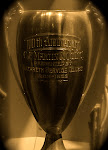
 Although C.F. Martin had produced a handful of artist-branded guitars prior to 1932, unlike other companies during the period, they didn’t market the instruments themselves. Guitarists such as Vahdah Olcott-Bickford who had been ordering numerous artist-branded guitars from Martin since the teens, were solely responsible for the marketing/sales of her exclusively branded line.
Although C.F. Martin had produced a handful of artist-branded guitars prior to 1932, unlike other companies during the period, they didn’t market the instruments themselves. Guitarists such as Vahdah Olcott-Bickford who had been ordering numerous artist-branded guitars from Martin since the teens, were solely responsible for the marketing/sales of her exclusively branded line.The idea of an artist-endorsed instrument was popularized by 1926, when Gibson first branded its Nick Lucas Model in their freshman year of building flattop guitars. That same year, Harmony created their custom line of Roy Smeck "Vita" instruments. However, Smeck obviously preferred his Martin instruments and continued to perform with them throughout the 20s and 30s.
Roy Smeck, a native of Pennsylvania, had been dealing with Martin since his early days in vaudeville. By 1932 he had already had his hands on two of the most important Martin guitars produced during the company’s greatest period of innovation. Smeck is responsible for ordering the first Dreadnought guitar made after the initial run of Ditson branded “Dreadnaught” shaped instruments, revitalizing the Dreadnought model from extinction. While visiting the North Street Factory in 1929, he also strummed the custom 14-fret 000-28 made for Perry Bechtel of Atlanta. In a 1929 letter from C.F. Martin III to Bechtel, Martin noted that Smeck thought Perry had “great foresight in having the guitar made-up.”
Speaking on Smeck’s behalf in 1932, Alex Kolbe, late-night Smeck pal and editor of the Musical Merchandise Magazine, again asked Martin if they would consider branding a Martin/Smeck guitar. Kolbe writes: “Now here is the reason for my writing you the forementioned. Gibson in Kalamazoo and the Schireson Bros. in Los Angeles and two Eastern houses have been after Mr. Smeck for the purpose of putting out a line of guitars bearing his name. Two other companies in question were agreeable in organizing a Roy Smeck firm and for some unknown reason, Roy Smeck prefers his Martin guitar.”
In 1932 C.F. Martin & Co. was working at 60% capacity, having laid-off many of their workforce due to the struggling economy. The idea of having one of the most popular guitarists in the nation endorsing Martin guitars must have first been appealing for C.F. III, however, his response was most eloquent.
“Thank you for your interesting letter with the suggestion that we put out a Roy Smeck line of Guitars. Considering the matter impersonally, because the fact that we like Roy and wish him all possible success would not be a sufficient motive, we must be guided by out policy in such matters and that is to put the greatest possible intrinsic value in Martin Instruments but not to use the name of any individual in addition to or in place of our own. While there is undoubted advertising value in the names like Nick Lucas and Roy Smeck, we still think that our policy of sticking to our own name is right. In years past we have made for certain customers special lines bearing their name; for example, a Ditson line, and we are willing to do that now if Mr. Smeck himself or any suitable dealer or jobber wishes to market a Roy Smeck line. In such cases we advise the use of our name as well as the special name because the experience has been that the name Martin helps to put the goods across. In sort, we are willing to make a Roy Smeck line of instruments but we do not care to market them. That gives you something to think about.”
 In 1934 Gibson produced the “Jumbo” line of Roy Smeck Stage Deluxe Hawaiian guitars. As the Wizard progressed throughout his career in the 1930s, he abandoned his favored Martin 00-40H for his newly endorsed model. However, according to Smeck, only a Martin was good enough.
In 1934 Gibson produced the “Jumbo” line of Roy Smeck Stage Deluxe Hawaiian guitars. As the Wizard progressed throughout his career in the 1930s, he abandoned his favored Martin 00-40H for his newly endorsed model. However, according to Smeck, only a Martin was good enough.

